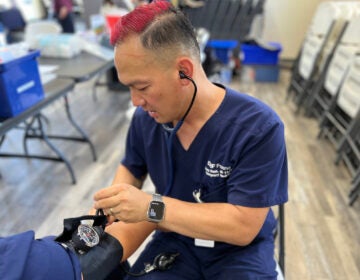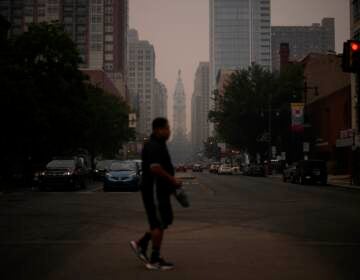As farmworkers face longer, hotter harvest seasons, their risk of heat-related illness grows
Agricultural workers in the U.S. are 35 times more likely to die from heat-related stress than people working in any other field.
Listen 12:08
Migrant farmworkers pick a vegetable crop on an early morning in Fresno, Calif., on July 18, 2025. (AP Photo/Damian Dovarganes)
This story is from The Pulse, a weekly health and science podcast. Subscribe on Apple Podcasts, Spotify, or wherever you get your podcasts.
Listen to the full episode on Protecting the People Who Grow Our Food
It was 7 p.m. on June 24, only the third official day of summer, and the temperature was still a scorching 99 degrees. Emma Cortes, a global emergency medicine fellow at Brown University and founder of the Migrant Health Collaborative of South Jersey, a nonprofit working to expand health care access for the state’s migrant farmworkers, was delivering hygiene kits to several worker camps in the area.
She met up with Jose Eduardo Sandoval Herrera, a migrant farmworker from Mexico who has spent the past 12 summers working in New Jersey.
“The heat is a bit strong and sometimes you feel like you’re suffocating because the sun is so strong,” said Herrera.
He said that just days earlier, a worker on the farm from Haiti had been rushed to the hospital due to heat stroke.
At the time, Herrera was packing blueberries at a warehouse in the small town of Hammonton, New Jersey. Unfortunately, the air conditioning at the warehouse offered little relief to the workers. And even worse, the housing provided by their employer had no AC at all.
“So if there is no equipment to keep the houses cool, obviously you are not going to perform at work,” he explained. “Because you can’t even sleep, you won’t rest well. And the next day even your strength is gone because of the heat.”
But it’s not just their work performance that can suffer, heat can have a heavy impact on a farmworker’s health.
The toll of extreme heat
Heat-related illness occurs when the body can’t cool itself. Early symptoms include cramps, nausea, fatigue, and headaches. In the most severe cases it can lead to a heat stroke and even death. But despite the risks, many farmworkers have little choice but to keep working in the heat. They are afraid to lose the wages they depend on to support themselves and their families.
Omar Sánchez García, a 35-year-old from Avenal, California, said that within a year of working on farms, he had already been sick from the heat.
In early June, García was working at a peach farm. His shifts started at 6:30 a.m. and ended by 2:30 p.m., but he says the heat really starts to kick in by 10 a.m.
“You slow down, and the bosses want you to keep going faster and faster, but you can’t,” García said over Zoom.
Even when workers start to feel dizzy, fatigued, or their vision blurs, many workers push through.
“They don’t want to say anything and act like tough guys until they end up getting a heat stroke,” he said.
His wife, Teresa Sandoval, is also a farmworker. She recalled a pretty scary experience from when she first started working in the fields in 2006.
“I was working on a grape farm and out of nowhere I started to feel bad. I couldn’t breathe,” Sandoval said. She panicked and tried to find her supervisor.
“I started to get scared because I couldn’t find anyone. I thought I was going to die there,” Sandoval said.
She eventually found him. He immediately removed her hat, put ice on the back of her neck, and told her to drink water. She was lucky and recovered, but she was right to feel scared.
In fact, heat has been the leading cause of death among weather-related phenomena on average over the last 30 years in the United States — more fatal than floods, tornadoes, and hurricanes combined.
Additionally, agricultural workers in the U.S. are 35 times more likely to die from heat-related stress than people working in any other field, according to federal data. And as climate change drives temperatures higher, farmworkers are laboring through longer and hotter harvest seasons, and the risk of heat-related illness grows.
Hidden long-term risks
Even for workers that manage acute symptoms of heat-related illness, there is a risk of long-term impacts.
“The kidney can directly be affected by heat stress through many mechanisms, right?,” said Nicolás López-Gálvez, an assistant professor at the School of Public Health at San Diego State University. “One is the lack of hydration because the kidneys are usually our filtration system. So the moment we start providing them less liquid and all of a sudden doing the process faster, they cannot pretty much recover as fast.”
He has been researching a mysterious rise in chronic kidney disease among farmworkers in particularly warm countries close to the equator.
In 2019, while at the University of Arizona, he conducted a study of 101 migrant farmworkers in Sonora, Mexico, where summer temperatures regularly reach 100 degrees. The workers, mostly from southern Mexico and Central America, were divided between organic and conventional farms, while a separate control group of 50 office workers was also monitored.
The researchers kept close tabs on all the workers and collected various data points including blood and urine samples throughout the study period to monitor the workers’ kidney function.
By July, one farmworker developed kidney disease. Two others suffered from what is known as an acute kidney injury or the sudden, short-term loss in kidney function, and 14 were at risk of a kidney injury. Overall, kidney function was also slightly lower among workers that worked on conventional farms than those that worked at organic farms, suggesting pesticides could also be playing a factor. The people working inside an office saw no significant changes in kidney function.
López-Gálvez is now involved in two major research projects. The first, the Rural Heat Islands Project, equips workers with sensors to monitor their body temperature and other health stats and compares the data with weather station readings. The goal is to eventually be able to predict in real time the conditions workers face in the fields.
The other study focuses on researching more practical ways to protect workers. They’re testing everything from training and adjusting work shifts, to providing workers with cooler work clothes and even AC units for their homes.
Meanwhile, farther up north at the University of California, Santa Cruz, Matt Sparke, the school’s co-director of the global and community health program is working on a more tech–forward approach.
His team has developed an app called Campo-Sano, the name means healthy field in Spanish. The app aggregates state data including things like temperature, air-quality, and pesticide use into one location.
“ So our project has been, first of all, to map where these problems intersect on the ground and create a map app that community health workers and farmworkers can use themselves to see what those problems look like, specifically in their own place of everyday life and where they work,” said Sparke.
The app also provides links to resources for farmworkers and has a form they can fill out to report any climate-related risks or workplace violations.
Sparke and his students work alongside promotoras, or community health workers, to train farmworkers on using the app. Some of the students come from the area and have relatives who have worked in the fields, giving them a personal connection to the work. The trainings also cover the different health risks farmworkers face due to climate change and how to mitigate those risks.
Subscribe to The Pulse
The fight for federal protections
Right now, only seven states in the U.S. have state-wide regulations that protect workers from extreme heat — California, Colorado, Maryland, Minnesota, Oregon, Nevada, and Washington.
Federal protections for workers against extreme heat, proposed last year by the Biden-Harris administration, are still under review. This summer, the Occupational Safety and Health Administration (OSHA) held a two-week long hearing regarding the proposed regulations.
The proposed rules, as they are currently written, would require employers around the country to provide workers with water, a cool place to rest, and regular breaks, depending how hot their worksite gets. At certain temperatures, it would also require employers to regularly monitor workers for signs of heat-related illness.
Alexis Guild, the vice president of strategy and programs at the advocacy group Farmworker Justice, testified at the hearing. She recommended that the rules include strong protections against retaliation for workers who assert their rights. Many, she said, stay silent about abuses out of fear of losing wages, being fired, or, for undocumented workers, being reported to immigration authorities.
Additionally, when I spoke with her in May, she explained that paid rest breaks would be essential for these rules to really make a difference for farmworkers.
“Because farm workers are often paid by the piece rate, and so taking a break can mean lost wages, ” said Guild. “So, if they don’t have that guarantee of a paid rest break, farmworkers may be less incentivized to access water, to take a break and go into the shade and cool down.”
The rules face opposition from groups like the U.S. Chamber of Commerce, which argues they are overly broad and burdensome, especially for small businesses. And even if adopted, the current administration could decline to enforce them.
Guild told me that tackling an issue as complex as this one is more of a marathon than a sprint.
“Having federal regulations is important, but would that mean that everything would be perfect? Absolutely not,” said Guild. “It’s very complicated and all these different pieces, the community health workers, the training, the education, the outreach, the regulations, they all work hand in hand.”
WHYY is your source for fact-based, in-depth journalism and information. As a nonprofit organization, we rely on financial support from readers like you. Please give today.






